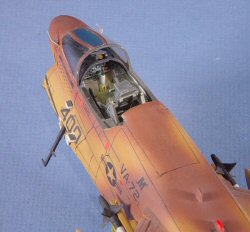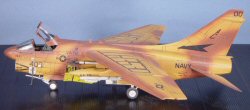
Hasegawa 1/48 A-7E Corsair II Build Review
By Michael Benolkin
| Date of Review | July 2005 | Manufacturer | Hasegawa |
|---|---|---|---|
| Subject | A-7E Corsair II | Scale | 1/48 |
| Kit Number | 07012 | Primary Media | Styrene |
| Pros | Beautiful detail, nice fit throughout | Cons | |
| Skill Level | Basic/Intermediate | MSRP (USD) | $37.98 |
Background
The Ling-Temco-Vought (LTV) A-7 Corsair II was developed under a US Navy requirement for an improved strike aircraft to replace the A-4 Skyhawk. The engineers at LTV adapted the design of their very successful F-8 Crusader family to meet this requirement by shortening the fuselage (no afterburner required), eliminating the variable incidence wing, adding additional weapons stations, and installing new avionics. The resulting design still bore a striking resemblance to the Crusader, but the shorter fuselage length was the heart of the A-7’s unofficial nickname – SLUF (Short Little Ugly ‘Fella’).
The A-7 was such a successful attack aircraft that the USAF acquired the A-7D to fulfill its own strike and close air support requirements. The A-7E, like the A-7D, was armed with the 20mm M61 Vulcan gatling gun, replacing the two 20mm cannons arming the earlier SLUFs. The visible difference between the A-7D and the A-7E (besides the paint job) was the air refueling system. The A-7D had a hump added to the fuselage aft of the cockpit housing the air refueling receiver, whereas the A-7E (and all other USN SLUFs) had a retractable air refueling probe mounted on the right side of the nose, just under the canopy.
The A-7 distinguished itself during the Vietnam war flying over 90,000 sorties and experiencing the lowest combat loss rate of any Navy combat aircraft in the theater. The aircraft would continue as the mainstay US Navy strike aircraft until finally replaced by the F/A-18 Hornet. In fact, the last two SLUF squadrons would delay their transition into the Hornet to deploy overseas in support of Operation Desert Shield/Desert Storm. Upon returning from Iraq, these last two squadrons turned in their Corsairs for the new Hornet.
The Kit
The Hasegawa 1/48 A-7E (and A-7D) Corsair II kits are absolutely beautiful. Molded in light gray styrene, this kit features finely scribed panel and rivet detail. A small fret of three photo-etched parts is also included to represent the fuselage skin reinforcement for the cable conduits on either side of the fuselage under the wings, and for the refueling probe housing. The clear parts are absolutely clear and are molded to support positioning of the canopy open or closed. If you’ve seen the model built before, you’ve noticed the open avionics bays on either side of the fuselage. These aren’t aftermarket conversions; these are part of the exquisite detail provided in the kit!
Assembly
While there are some nice aftermarket resin cockpits available for the Hasegawa kit, the kit’s cockpit is one of Hasegawa’s best out of the box. I assembled and painted the cockpit per the kit instructions with the help of Bert Kinzey’s A-7 Corsair II in Detail & Scale and A-7 Corsair II Color & Markings titles. I replaced the kit ejection seat with the resin seat in Verlinden’s Corsair Update Set. Selected photo-etched parts from my spares were also used to augment the kit’s cockpit.
As with any two-piece intake, eliminating the ugly seam that is visible from any forward viewpoint is no small chore. I solved this problem using an aftermarket seamless intake. The resin intake also had the required details for the nose wheel well and is compatible with the kit wheel well parts. Assembly of the fuselage is very simple, capturing the cockpit, intake trunk and tailpipe in the process.
I opted to keep the positionable ventral speedbrake closed, while having all of the avionics bay doors open. The only required use of cyano is installing the three photo-etched parts that serve as the skin stiffeners and are actually sandwiched between the fuselage and other plastic parts.
The wing assembles without any problems. You have the option of positioning the leading edge and trailing edge flaps up or down, and the outboard wing sections folded or in flight position. I opted for flaps extended and wings down and locked.
While I painted and detailed the landing gear, I opted to leave them off the aircraft until after painting. Decals are provided for the various placards on the landing gear doors and landing gear struts, a very nice touch, Hasegawa!
The final step before heading to the paint rack was installing the weapons pylons and the external stores that I would use on this aircraft. I elected to use the two 300 gallon external tanks on the inboard stations and two empty multiple ejector racks (MERs) on Stations 3 and 7. I left stations 1 and 8 empty to show off the kit’s anti-sway braces that are provided in the kit for these pylons, another nice touch, Hasegawa!
Painting
I was fascinated by the two-tone brown paint scheme applied to the CAG’s aircraft after the end of hostilities in Desert Storm. A picture of this aircraft is on the cover of Bert Kinzey’s US Aircraft & Armament of Operation Desert Storm. Superscale had released these markings in set 48-411, which I had dutifully acquired and stashed away. Since I did not have the equivalent FS matches, I opted to use Tamiya’s Hull Red and Desert Yellow acrylics for the two colors.
After a coat of Future, I applied the Superscale markings and stencils according to the instructions. As usual, the Superscale decals respond nicely to MicroSol and MicroSet. After all of the decals were placed, I applied another coat of Future to protect them from the next step.
I decided to try using a very fine technical pen to ‘draw’ in the panel lines and details. The results were striking, if not too bold, but given the time taken to get the job done, I’ll stick with black oil washes in the future. The completed aircraft was treated to one last coat of Future mixed with Tamiya Flat Base to create a dull finish.
Final Steps
Now that the painting and other manhandling are complete, it is time to install the landing gear, anti-collision lights, avionics bay doors, external stores, and other details. There were no surprises anywhere along the way during assembly, even using the aftermarket accessories in the kit. I found that the canopy would stay open due to the tight friction fit of the frame against the fuselage, so I am able to close or remove the canopy for transport.
Conclusions
This kit is one of Hasegawa’s best for ease of assembly and for the level of detail straight out of the box. Using a resin cockpit or the detail set from Verlinden will enhance the project, but these aren’t really required unless you suffer from AMS as I do. The one essential aftermarket enhancement is the seamless intake trunk from Seamless Suckers. Unfortunately, they are not online but you can usually get one at IPMS Nationals (as I did) or online from CRM Hobbies in Saint Louis, MO.
This is a fun build and the fortunately Hasegawa continues to produce this kit under its new business strategy of limited releases with different markings. While the kit is an easy build, I would recommend this kit to at least novice modelers with some building experience and experience with cyano adhesives. More experienced modelers will have a field day with the variety of aftermarket accessories and decals that have been produced for this kit and the A-7D as well.
My sincere thanks to my wife for looking the other way when I go shopping for these projects!
This kit is highly recommended!


















